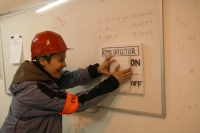 |
 |
|||||||||||||
|
|||||||||||||
|
|||||||||||||
|
Katrin Voss really need the pain au chocolat géant for breakfast at the CERN cafeteria for getting started with her first visit to CERN on 6 April. Germany’s new CERN/LHC Communicator describes her first impressions of tunnels, detectors and campus life at CERN’s recent Open Day as "a demanding yet rewarding experience". Being the new CERN/LHC Communicator for Germany but not having a degree in physics (I worked at the press office of the Centre for European Economic Research in Mannheim, Germany, for the past ten years), the CERN Open Day was an excellent opportunity to learn more about particle physics and "the world's largest particle physics laboratory" that I wouldn't have wanted to miss. The crowds were massive, but with the help of a press badge I managed to see a good variety of events and places. I started the Open Day at the ATLAS experiment. Although I had seen quite a few photographs of ATLAS before coming to CERN, I was amazed at the sheer size of the experiment. The information that 4 000 kilometres of cable had been installed in it is almost inconceivable for someone who has never had to do with particle accelerators. Equally interesting were the visit at the ATLAS control centre and the short 3D film about the construction work at ATLAS. I also visited CMS. Here, the dimension of the detector became even more visible than at ATLAS as the different "layers" of the detector could be seen clearly and it was possible to walk on the ground of the cavern. Fortunately, one of the CMS scientists guided me around the facilities and explained the experiment. One thing that I found particularly interesting - and which could clearly be observed at CMS - was that the LHC was built slightly slanted so as not to cross several rock formations but rather to stay within one and the same layer of rock. Without having seen the LHC tunnel, an important piece would have been missing in understanding how a particle accelerator and in particular the LHC works. So I went underground yet again in one of the elevators, wearing one of the bright safety helmets and being squeezed together with my visitor group. Surprisingly not many people wanted to see the LHC tunnel and its installations. Even though the entrance was right next to the meeting point where the guided tour started, people were queueing for up to four hours to get into the ATLAS experiment and never saw the LHC tunnel. In the course of the day I also had a look at CLIC which aims at developing new techniques for a linear collider in the post LHC era. This was when I realised how long the planning and development of machines and devices in particle physics actually last. Another venue I visited was the CERN computer centre. I must admit that before going in I had thought "know one, know all", but the CERN facilities are definitely in a completely different league compared with other computer centres. At the end of the day, I was quite exhausted because of all the new information I had learned and all the new impressions I had gathered, and really felt that I had deserved the drink I had with colleagues at the CERN cafeteria after dinner. All around us there were many groups of people sitting together discussing and talking. This was when I discovered that this may be what I actually liked best about CERN and particle physics: meeting with people from different countries and the communicative atmosphere. -- Katrin Voss, DESY |
|||||||||||||
| © International Linear Collider |

